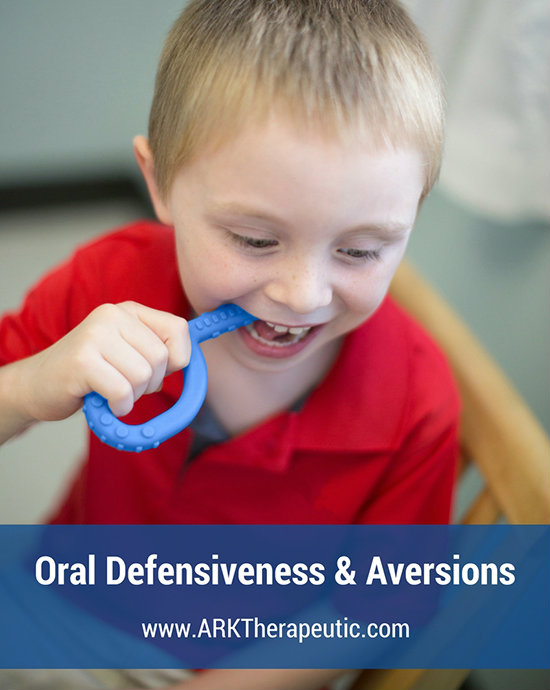Oral Defensiveness & Aversions
Posted by Debra C. Lowsky, MS, CCC-SLP on 2nd Aug 2011
Oral defensiveness falls into two main categories: HYPOsensitivity and HYPERsensitivity: .
• Individuals with hyposensitivities have low oral tone and very little awareness of what's going on inside their mouths. This "oral numbness" so to speak can cause significant speech and feeding delays. For example, the ability to create a food bolus is a critical oral motor skill necessary for swallowing. But how can I teach this skill to an individual who cannot feel his tongue? Lack of awareness can also lead to mouth stuffing, leftover food particles in and around the mouth, drooling, etc. In these cases, it is important to increase oral awareness by providing varied oral input and sensation throughout the oral cavity. It is at this point, however, that hyposensitive individuals can become orally defensive. Because they are not used to new feelings and sensations inside theirs mouths, they may be afraid/unsure of the sensations and therefore refuse intervention.
• On the other hand, individuals with hypersensitivities are overly sensitive to oral stimulation. Even the slightest touch might be uncomfortable and even painful, which can lead to texture/food aversions, picky eating, and speech and feeding delays. Let's say, for instance, that an individual needs to work on tongue lateralization. To do this, I usually use an oro-Navigator to guide the tongue to one side of the mouth and then to the other. Or, I'll place the Probe Tip inside the cheek area and tell the individual to touch it with the tip of the tongue. But how can we do these exercises if the individual won't allow anything near the mouth because it hurts?
.

.
Although these two forms of oral defensiveness are different, intervention is quite similar for both - you need to get into the mouth and provide input in order to normalize sensation. As you proceed with the strategies below, keep in mind that there is no one approach or one answer. Each individual has different needs that will in turn require a different approach. .
• Before beginning any treatment plan, I recommend that you first see a dentist to rule out any medical issues that may be the underlying cause of oral sensitivities. For example, if the teeth haven't been routinely and properly brushed, the gums may be sensitive, which may be confused for oral defensiveness. Once medical complications have been ruled out, I recommend seeing a speech-language pathologist and/or occupational therapist trained in sensory processing disorders. These professionals will be able to complete a sensory evaluation and put together a treatment plan considering all factors.
• Before starting intervention, you'll first need to establish a calm and supportive environment. The children who I work with are very adept at sensing any frustration, overeagerness, and being in a rush, so I need to constantly monitor what emotions I am displaying. I work at maintaining a stress-free therapy atmosphere by staying relaxed, patient, and showing them that I care. When working with oral aversions and sensitivities, it is very important that the individual feels comfortable and trusts you. So proceed slowly, following the individual’s lead and stopping BEFORE he/she becomes overloaded.
• If you can get into the mouth, gum massage is a great activity to begin with, as it provides input to all areas of the mouth. This tactile feedback can be very calming and enjoyable for hyposensitive individuals and can slowly desensitize the mouth for hypersensitive individuals.
• You can also provide the individual with chew tools to explore their mouths. The Grabber and Y-Chew were specifically designed with long extensions that reach all the way to the back molar area for proprioceptive input. The Animal Tips are also great for mouthing a variety of textures and shapes.
• Vibration with the Z-Vibe and Z-Grabber can be effective in decreasing oral defensiveness/aversions/sensitivities. Many individuals find it soothing and calming. Others, however, may not like it at all. Each individual is wired differently, and using vibration will depend on the individual’s preference. I don’t insist that all the children who I treat use the Z-Vibe with vibration. In some cases, I opt to just not turn it on. Even without vibration, getting into the mouth and presenting different textures, shapes, and sensations will be beneficial. Use the various tips to tap, stroke, and apply gentle pressure to the lips, tongue, cheeks, and gums. Vary your pressure, the length of your strokes, and the duration of the stimulation.
• If the individual’s diet has limited textured foods, I start with the Textured Spoon Tip, which has bumps on the bottom for added sensory input. You can also use the Probe, Preefer, Mini, and Animal Tips as spoons – just dip them in whatever the individual will eat and feed it to them. .
.
.
• For individuals who are not used to the Z-Vibe, you may need to introduce it to them slowly. Present it gradually through play, beginning with touching it on the leg, arm, etc. It may also help to use the friendly Animal Tip "pets" and/or the fun Popette Tip first to spark interest and participation.
• If the individual is very sensitive, you may need to take a step back and identify exactly where the oral aversion is. Is it the on the lips, inside the cheek areas, on the gums, teeth, different parts of the tongue, the whole tongue, etc.? Use the Probe Tip to touch each area of the mouth. Make a note of which areas are too sensitive. Once you identify these areas, use the smooth side of the Probe Tip to touch them. Just touch them first. Then apply gentle pressure. You can also try brushing those spots back and forth (please note: if you're trying to de-sensitize the gums, use the soft Brush Tip - it has pliable bristles are gentler on the gums.) It may take some time before this starts to feel more comfortable. Once the individual has acclimated to a touch, pressure, or brush with the smooth side of the Probe Tip, proceed to using the striated side of the Probe Tip (which provides more input), followed by the nubby side of the Probe Tip (which provides the most input). This progression allows for a gradual acceptance to tactile input.
• Repeat the above exercises as often as possible throughout the day, especially before eating meals/snacks, as this may increase acceptance to more foods. These mealtime sensory strategies may also be helpful as well as these tips for decreasing food aversions.
.
How long should you do these exercises? Again, this is entirely up to the individual. Proceed slowly, follow their lead, and stop stimulation when/if the individual shows signs of discomfort. Then try to work past that point in the next session.
Throughout the intervention, make sure that you tell the individual what you're doing and why. This will give them more control over the situation and help reduce anxiety.
A reward system may also be useful. My kids love the iPad, so if they accomplish x exercise, I reward them with their favorite app.
Sometimes it helps to create a visual schedule of the exercises and rewards so that they can see the tasks and what is expected of them. The predictability of a schedule also helps keep anxiety to a minimum.
Counting generally works as well. Tell the individual you are going to count up to 2, 3, 5, etc. so they can predict when you will be finished (and make sure to actually stop when you say you will).
While the above methods can certainly be helpful in treating individuals with Sensory Processing Disorder, they are not the only treatment strategies. As an SLP, I work closely with the child’s OT to work on sensitivities within the oral cavity and throughout the body. The OT also has suggestions on how to incorporate sensory activities into my therapy sessions. Treating individuals with oral defensiveness requires a team approach. It is important that the SLP, OT, caregiver, and dentist and dietician (if necessary) work together to implement an intervention plan.
As always, patience, perseverance, and creativity go a long way.
.
I hope you find this information useful!
Debbie
Debra C. Lowsky, MS, CCC-SLP
.

